archeryrob
Smoking Fanatic
Yeah no kidding on the civility. FB canning groups they string you up for violating the FDA rules, Its like "Canning Karen's". But 100 years back or so there was only water bath canning and people used it. It is not the preferred method to can low acidic things. I too pressure can meats and such. I was just stating, "You can do it" not that I do, or recommend it.
I wish I has an option for things like peach and pawpaw butter besides adding the lemon the recipes call for. It completely ruins pawpaws when adding the lemon. It's thick stuff and figure it might burn or separate or something when pressure canned?
On the civility. We had chickens raise for meat and eggs and those people would go nuts if you spoke about culling chickens. You can buy them in the store, but you can't eat the ones in your coops? I had to create a new group Maryland chickens, meat and layers, just to avoid the backyard chicken freaks.
I wish I has an option for things like peach and pawpaw butter besides adding the lemon the recipes call for. It completely ruins pawpaws when adding the lemon. It's thick stuff and figure it might burn or separate or something when pressure canned?
On the civility. We had chickens raise for meat and eggs and those people would go nuts if you spoke about culling chickens. You can buy them in the store, but you can't eat the ones in your coops? I had to create a new group Maryland chickens, meat and layers, just to avoid the backyard chicken freaks.







